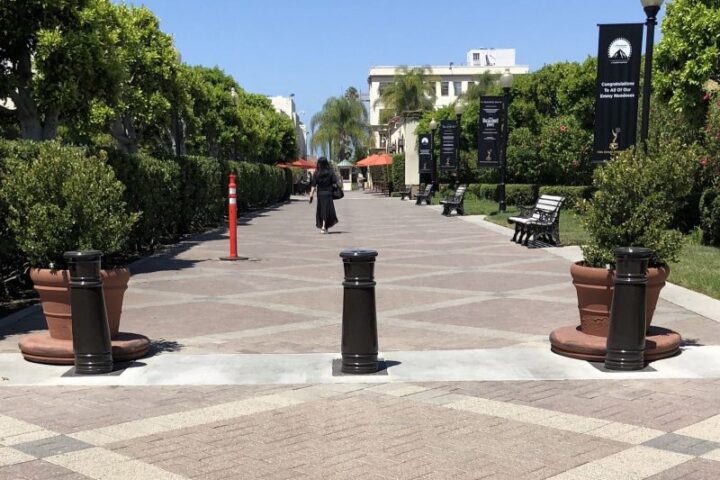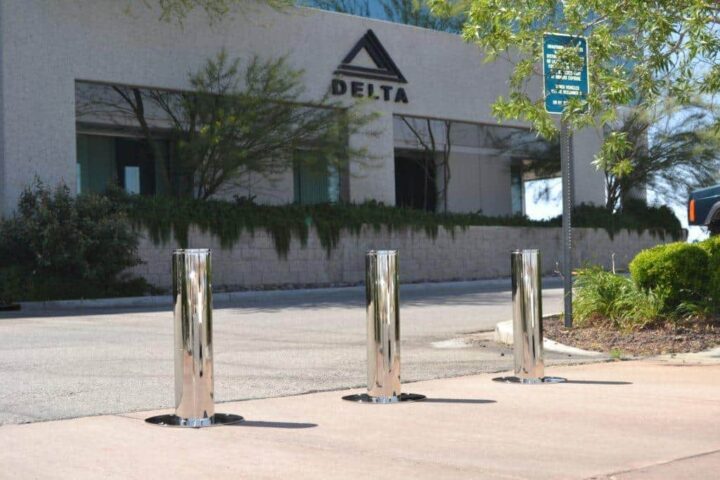Bollards, those waist-high posts standing guard along city streets and around important buildings, offer security and can add a touch of urban design; however, they’re often a permanent fixture. What if you need a security barrier only for a temporary period?
Parking Bollards: The Best Options and How To Set Them Up
Parking bollards are key tools for limiting vehicle access, protecting properties, and keeping pedestrians and other drivers safe. However, there are several different types of parking bollards available, with different pros and cons for each one. It’s important to understand where parking bollards are most useful to evaluate whether a specific type is the right solution.
How Building Protection Bollards Improve Public Building Aesthetic
It’s an unfortunate reality that terrorist attacks, both in the United States and abroad, have turned motor vehicles into weapons. These attacks have involved cars and trucks barrelling into large crowds, pedestrian areas, and college campuses. Many other targets, such as sports stadiums, community centers, and government buildings, could see a vehicular attack. In order to treat the threat of these attacks seriously, companies and event organizers should consider utilizing building protection bollards.
Your Guide to Typical Bollard Code Requirements
Bollards are short, sturdy posts installed in the ground, or just at the surface, to create a boundary between a roadway and a building or pedestrian area. Bollards allow foot traffic to flow freely while signaling to drivers that vehicles cannot enter a certain area. Bollards can even add aesthetic appeal. When installing Delta Scientific bollards, you must comply with applicable bollard code requirements. These may be part of a larger building code and ensure that the construction is safe for the general public.
How Much Does Bollard Installation Cost?
When you purchase bollards from Delta Scientific, you make an investment in safety. You protect your employees, clients, or constituents from collisions with speeding vehicles. You also protect yourself from liability that you may face as a result of such a collision taking place on your property. As a responsible property owner or manager, you should consider bollard installation cost when planning your budget.
What Is the Standard Bollard Height?
A bollard is a short, sturdy post installed into the ground. It delineates parking areas and pedestrian areas. Bollards that offer crash protection, such as those we offer at Delta Scientific, prevent cars from crashing into buildings or onto walkways, causing injuries and property damage in the process. Bollard height is an important consideration when you are purchasing access control systems.
The 4 Types of Perimeter Security Bollards
There is an undeniable increase in the number of attacks on citizens, communities, and businesses using a vehicle as a weapon. Whether the perpetrator is a member of a terrorist cell or a home-grown malcontent, the destruction is devastating. The loss of life and property can be incalculable, making prevention strategies an essential step in protecting your facility and your community from malicious attacks.
Methods of Testing Different Types of Bollards
Originally, a bollard was a post installed into the shore alongside a wharf to allow sailors to tie up boats and ships. The word is still used in this respect, but because ships of today tend to be much larger and made of heavier materials than the ships of the past, the bollards have to be much sturdier and stronger.
Types of Bollards and Their Uses
Most people have probably seen bollards before but not known what they were called. Some people refer to them by a more generic term, such as “traffic barriers.” A bollard is a vertical post that is short and sturdy used for security to prevent vehicles from crashing into buildings or pedestrian areas. Learn about the different bollard types, their history, and their uses today to see how these security devices continue to protect buildings and pedestrians around the world.
Does OSHA Require Safety Bollards?
The Occupational Safety and Health Administration was created in 1970 by an act of Congress. Its mission is to set and enforce safety standards to ensure working conditions that are safe and healthful for employees and to minimize hazards that employees could be exposed to in the workplace. Sometimes, this requires the installation of security equipment, such as safety bollards.










